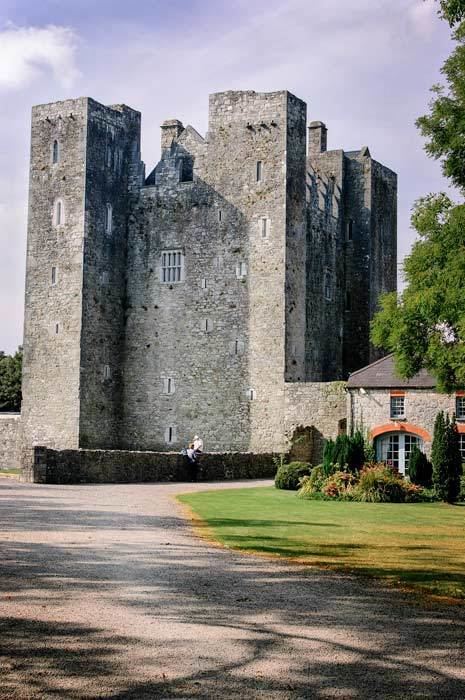Name Sir Meade, | ||
 | ||
Sir John Meade, 1st Baronet (1642–1707) was an Irish barrister, judge and politician. He was the first of the Meade Baronets of Balintubber, and an ancestor of the Earl of Clanwilliam. He was unusual in his era for his lack of ambition to become a judge of the High Court, despite being widely regarded as a lawyer of "excellent parts". In matters of religion he seems to have been, by the standards of his time, a man of very tolerant views: although he was himself a Protestant, he damaged his career by marrying Elizabeth Butler, who was a Roman Catholic, as his third wife.
Contents
Early life
He was born in Cork City, son of Colonel William Meade and Elizabeth Travers; he was a grandson of Sir John Meade senior, of Balintubber, and through his paternal grandmother, Catherine Sarsfield, a great-grandson of the notoriously corrupt judge Dominick Sarsfield, 1st Viscount Sarsfield. His mother Elizabeth Travers was the daughter of Sir Robert Travers (died 1647), Judge Advocate of Ireland and member of the Irish House of Commons for Clonakilty, who was killed at the Battle of Knocknanuss, and his second wife Elizabeth Boyle, daughter of Richard Boyle, Archbishop of Tuam. Meade was thus a close family connection of the "Great Earl of Cork", Richard Boyle. His younger sister Eleanor became the fourth wife of Godwin Swift, uncle and guardian of Jonathan Swift, and another sister, Joanna, is recorded as the grandmother of the writer Laetitia Pilkington. By his third marriage he also became a member of the great Butler dynasty, although this proved to be something of a mixed blessing, as he married into one of the Roman Catholic branches of the family.
Career
He became Attorney General to the Duke of York (the future King James II of England), and Chief Justice (Seneschal) of the Palatine court of Tipperary. The latter office was generally seen as a sinecure, although the fact that there was normally a second justice (or Master of the Rolls) of the Palatine Court suggests that the workload was heavy enough. Meade was said to be a fine lawyer, but he seems to have had little interest in becoming a High Court judge, perhaps because his real interest was in politics. He sat in the Irish House of Commons, first for Trinity College Dublin in the Patriot Parliament of 1689, and then for Tipperary for the rest of his life.
Despite his willingness to sit in the Jacobite Patriot Parliament, he was regarded in his later years as a staunch supporter of William III of England. After the triumph of William's cause in 1690, he became King's Counsel, and was spoken of as a likely candidate for the office of Third Irish Serjeant in 1692. However, Henry Sydney, 1st Earl of Romney, the Lord Lieutenant of Ireland objected to Meade's appointment, referring cryptically to "some exceptions (i.e. objections) against him". This was probably a reference to Meade's third wife, Elizabeth Butler, daughter of the second Viscount Ikerrin, who was a Roman Catholic; such a marriage, after the downfall of the Catholic King James II, was a serious obstacle to high office.
Although he was noted for his Catholic sympathies, Meade was offered the office of Serjeant, after Lord Romney, and the whole of the Dublin Government, became deeply dissatisfied with the behaviour of the Prime Serjeant, John Osborne, who frequently acted without instructions from the Government, and even on occasions directly contrary to official policy. Meade refused the office on the ground that it would interfere with his flourishing private practice (although Hart notes that contemporary serjeants like Sir Richard Stephens became extremely rich through the perquisites of the office).
Lord Romney made it clear that his objection to appointing Meade to office had been no reflection on his character or reputation. In contrast to the "treacherous and ungrateful" Osborne, Romney remarked, Meade "has done very well, and is a man of most excellent parts: all the exception that can be made against him is that his wife is a Papist."
He was knighted in 1678 and made a baronet in 1703. He died in January 1707.
Family
Sir John married firstly Mary Coppinger, daughter of James Coppinger of Barryscourt Castle, County Cork; they had no children.
He married secondly Elizabeth Redman, daughter and co-heiress of Colonel Daniel Redman of Ballylinch, County Kilkenny and his wife Abigail Otway. Redman was a Cromwellian army officer, who had purchased substantial lands in Ireland from his brother-in-law Captain John Joyner, who had begun his career as a cook in the household of King Charles I of England. John and Elizabeth had one surviving daughter-
He married thirdly in 1688 Elizabeth Butler, daughter of Pierce Butler, 2nd Viscount Ikerrin and his wife Eleanor Bryan. The 2nd Lord Ikerrin was a convert to Protestantism but his son James, the 3rd Viscount (who married Eleanor Redman, sister of John Meade's second wife Elizabeth Redman), reverted to the Catholic faith, as, did Elizabeth herself. Her er Catholic beliefs became a barrier to her husband's career advancement. She died in 1757. They had at least eight children-
